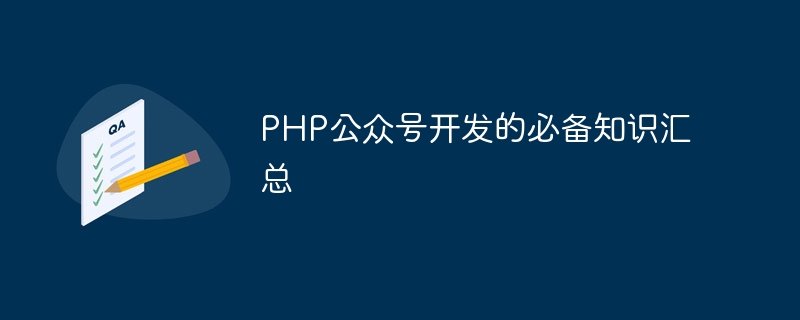Home >Backend Development >PHP Tutorial >Summary of essential knowledge for PHP public account development
Summary of essential knowledge for PHP public account development
- WBOYWBOYWBOYWBOYWBOYWBOYWBOYWBOYWBOYWBOYWBOYWBOYWBOriginal
- 2023-09-20 13:42:15849browse

A summary of the necessary knowledge for PHP public account development, specific code examples are required
With the popularity of the mobile Internet, WeChat public accounts have become an important means of communication between enterprises and users one of the important ways. As a popular server-side scripting language, PHP is also widely used in public account development. This article will summarize some necessary knowledge for PHP official account development and provide specific code examples to help readers better understand and apply it.
1. Configure the development environment
Before developing the public account, you need to configure the development environment first. The specific steps are as follows:
- Download and install PHP: Download the latest version of PHP from the official website, and then follow the installation wizard to install it.
- Configure PHP environment variables: Add the path of php.exe in the PHP installation directory to the system environment variables so that php commands can be executed directly on the command line.
- Install Composer: Composer is a dependency management tool for PHP. Through Composer, you can quickly introduce other libraries, frameworks, etc. Execute the following command on the command line to install Composer:
php -r "copy('https://getcomposer.org/installer', 'composer-setup.php');"
php composer-setup.php
php -r "unlink('composer-setup.php');"- Configure Composer environment variables: Add the path of composer.phar under the Composer installation path to the system's environment variables so that Composer commands can be executed directly from the command line.
2. Access the WeChat public account platform
- Register a developer account: Register on the WeChat public platform (https://mp.weixin.qq.com/) Developer account and create a public account.
- Configure the developer server: In the development settings of the official account, fill in the server configuration information, including URL, Token, EncodingAESKey, etc. The URL is the interface URL for the public account to receive messages and events. You can use any PHP framework to handle interface requests.
- Receive and process messages and events: Write a script to receive and process messages and events from public accounts. The specific code examples are as follows:
<?php
require_once __DIR__.'/vendor/autoload.php';
use EasyWeChatFactory;
$config = [
'app_id' => 'your-app-id',
'secret' => 'your-app-secret',
'token' => 'your-token',
'response_type' => 'array',
'log' => [
'level' => 'debug',
'file' => __DIR__.'/logs/easywechat.log',
],
];
$app = Factory::officialAccount($config);
$server = $app->server;
$server->push(function ($message) {
return "Hello, I'm EasyWeChat!";
});
$response = $app->server->serve();
$response->send();
3. Send a message to the user
- Text message: The following code example demonstrates how to send a text message to the user.
$textMessage = new EasyWeChatKernelMessagesText('Hello, World!');
$app->customer_service->message($textMessage)->to('user-openid')->send();- Picture message: The following code example demonstrates how to send a picture message to the user.
$imageMessage = new EasyWeChatKernelMessagesImage('path-to-your-image.jpg');
$app->customer_service->message($imageMessage)->to('user-openid')->send();- Graphic message: The following code example demonstrates how to send a graphic message to the user.
$newsMessage = new EasyWeChatKernelMessagesNews([
[
'title' => 'title',
'description' => 'description',
'url' => 'http://example.com',
'image' => 'http://example.com/image.png',
],
]);
$app->customer_service->message($newsMessage)->to('user-openid')->send();4. Obtaining user information
Obtaining user information is one of the commonly used functions in public account development. The following code example demonstrates how to obtain basic information about a user.
$user = $app->user->get('user-openid');
echo $user->nickname;
echo $user->headimgurl;5. Processing events
When the public account receives user messages, follow, unfollow and other events, it can be processed by monitoring related events. The following code example demonstrates how to handle user attention events.
$app->event->subscribe(function ($event) {
$user = $app->user->get($event['FromUserName']);
// 处理用户关注事件
});6. Material Management
The public account can upload and manage graphics, texts, pictures and other materials. The following code example demonstrates how to upload image material.
$media = $app->media->uploadImage('path-to-your-image.jpg');
echo $media['media_id'];7. Payment function
The public account can also implement payment functions to provide users with convenient payment methods. The following code example demonstrates how to generate a payment order.
$order = [
'body' => '订单支付',
'out_trade_no' => 'your-out-trade-no',
'total_fee' => 100,
'spbill_create_ip' => $_SERVER['REMOTE_ADDR'],
'notify_url' => 'http://your-notify-url',
'trade_type' => 'JSAPI',
'openid' => 'user-openid',
// ...
];
$result = $app->payment->order->unify($order);
$prepayId = $result['prepay_id'];The above is a summary of the necessary knowledge for PHP public account development, including configuring the development environment, accessing the WeChat public account platform, sending messages to users, obtaining user information, processing events, material management, and payment functions. I hope this article can help readers better develop PHP official accounts and provides specific code examples for reference.
The above is the detailed content of Summary of essential knowledge for PHP public account development. For more information, please follow other related articles on the PHP Chinese website!

